This tutorial assumes you’ve already logged in to Drupal
1) Click the Administer link

Now let’s learn how to manage themes
Themes are an easy way to change the look and feel of your Drupal site
2) Click the Themes link here
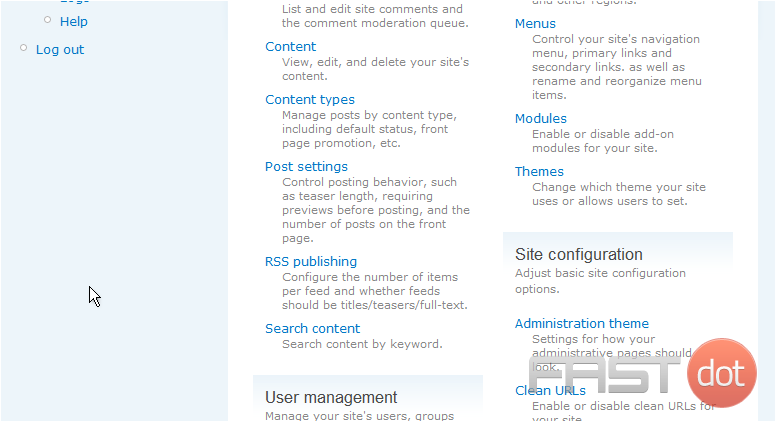
Comprehensive Guide to WordPress Website Development
Developing a WordPress website is a sequential process that requires careful planning, thoughtful execution, and consistent maintenance to ensure it meets the needs of users and achieves its intended goals. This involves a series of clearly defined stages, including planning, designing, content creation, optimisation, and ongoing maintenance. Each stage plays a crucial role in building a website that is not only visually appealing and functional but also secure, high-performing, and engaging for its target audience. By incorporating the right plugins and tools during these stages, you can effectively enhance your website’s capabilities and ensure that it delivers a seamless experience to its visitors.
Focus on these critical stages and leverage the recommended plugins to build a WordPress website that stands out in the competitive digital space and consistently delivers exceptional results.
-
What makes Fastdot.com such a great WordPress hosting provider:
Fastdot.com specialises in WordPress hosting and is highly regarded for its streamlined installation processes, robust and secure infrastructure, and round-the-clock expert support. This makes it an excellent choice for both beginners and experienced developers looking to ensure a reliable hosting environment for their WordPress websites. -
WordPress – Digital Experiences, Re-imagined:
In today’s rapidly evolving digital landscape, WordPress has emerged as a powerful and versatile platform, serving as a cornerstone for creating innovative and adaptive digital experiences. Initially launched in 2003 as a straightforward blogging tool, WordPress has evolved into a comprehensive content management system (CMS) that powers over 40% of all websites worldwide, demonstrating its adaptability and scalability for various online applications. -
How to Optimize Your Images to Speed Up WordPress:
Image optimisation involves reducing the file size of images without compromising their visual quality. This process is essential for enhancing your website’s loading speed, which directly improves user experience and boosts your search engine rankings. Implementing effective image optimisation techniques can significantly enhance the overall performance of your WordPress site. -
The Importance of WordPress Design:
WordPress, which powers over 40% of websites globally, plays a pivotal role in shaping modern digital experiences. Whether you are building a personal blog, a corporate website, or a complex e-commerce platform, the design choices you make will directly influence user engagement, brand perception, and conversion rates, making thoughtful design an integral part of the development process. -
MediaWiki on Fastdot: The Leading Australian Hosting Provider:
MediaWiki is an open-source platform renowned for powering Wikipedia. It enables users to create, edit, and manage large-scale collaborative projects and knowledge bases. When hosted on Fastdot, users benefit from a reliable infrastructure, ensuring that their MediaWiki projects run smoothly and securely. -
WordPress Hosting on Fastdot – Australia’s Leading Hosting Provider:
Fastdot stands out as one of Australia’s premier web hosting providers, offering robust, high-performance solutions specifically tailored for WordPress sites. Their advanced infrastructure, unparalleled security features, and expert support team ensure that your WordPress website operates efficiently and securely, no matter its size or complexity. -
Prestashop eCommerce Hosting – Australia’s Leading Hosting Provider:
PrestaShop is an open-source eCommerce platform trusted by over 300,000 online stores worldwide. It offers advanced functionalities such as product management, integrated payment gateways, SEO tools, and a rich ecosystem of themes and modules. When hosted on Fastdot, PrestaShop empowers businesses to create highly customisable and scalable online stores. -
How to Register a Domain Name:
Registering a domain name is one of the most critical steps in establishing an online presence, whether it’s for a personal project, a small business, or a larger organisation. This comprehensive guide walks you through the process of securing a domain name, ensuring that your website has a unique and memorable address on the internet. -
Flickr Group Feature – Challenge Accepted!:
This article highlights the unique dynamics of popular Flickr groups like Macro Mondays, where a shared focus and strong moderation foster vibrant online communities. Such groups demonstrate how collaboration and shared goals can create engaging and successful digital spaces.
3) Click here to enable a new theme…
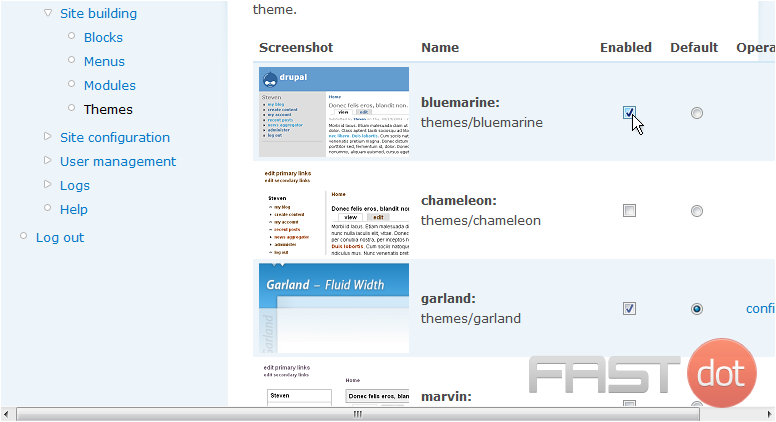
4) … then click here to make this new theme the default theme
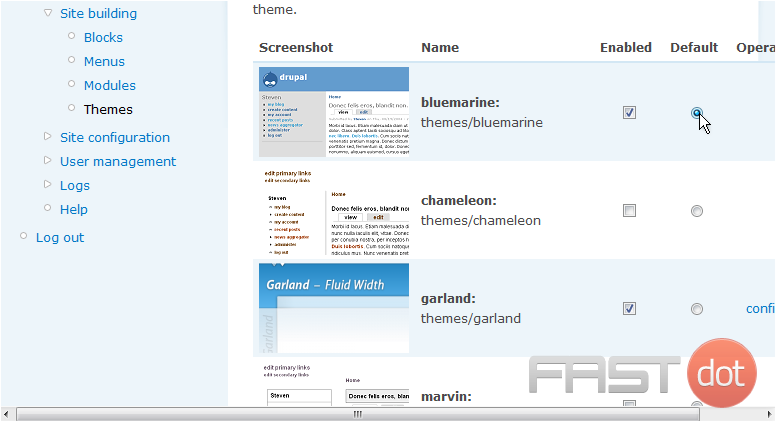
5) When finished, click Save configuration
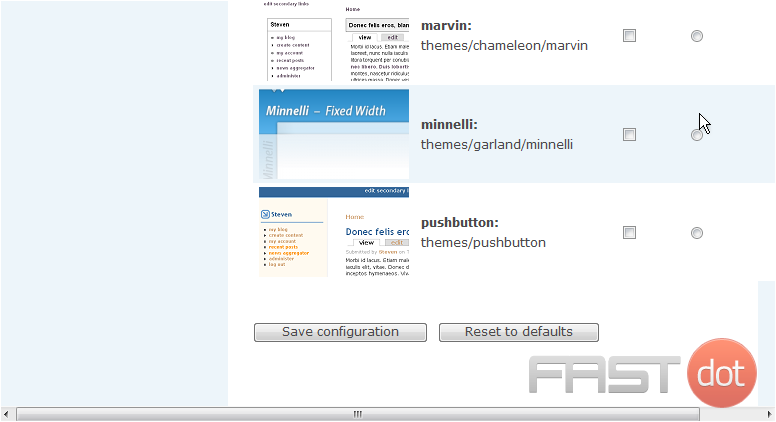
That’s it! As you can see by the look of the website, our theme has changed
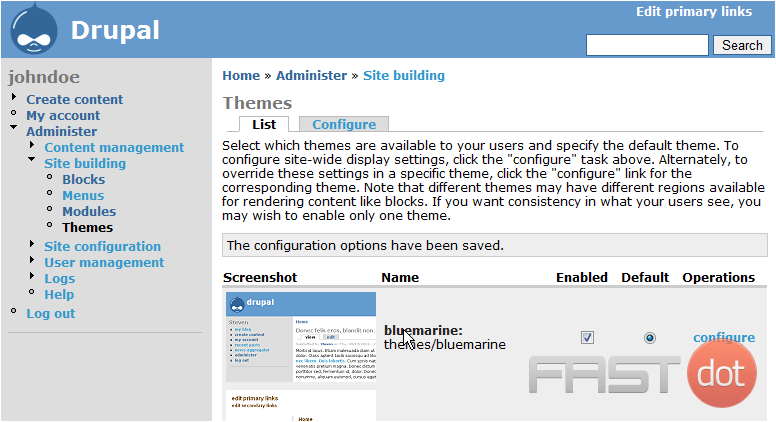
Let’s change our default theme back to the way it was
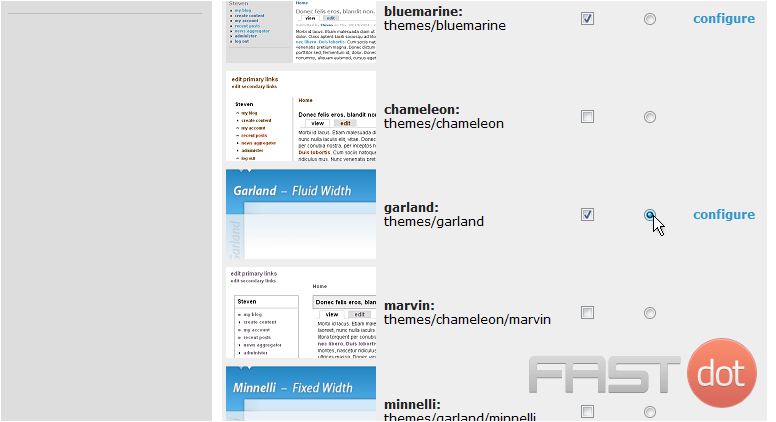
That’s all there is to it!

This is the end of the tutorial. You now know how to manage themes in Drupal
How to Manage Themes in Drupal
Managing themes in Drupal allows you to customize the appearance of your website. This guide will walk you through the steps required to install, enable, configure, and customize themes in Drupal.
Steps to Manage Themes in Drupal
Step 1: Log in to Your Drupal Admin Panel
- Access the Drupal site: Open your browser and go to the Drupal site where you want to manage themes.
- Log in: Click on the Log in link usually located at the top right corner of the page. Enter your username and password, then click Log in.
Step 2: Navigate to the Appearance Page
After logging in, navigate to the Appearance page:
- Click on Manage in the top menu.
- In the submenu, click on Appearance.
Step 3: Install a New Theme
To install a new theme, follow these steps:
- On the Appearance page, click on the Install new theme button.
- Enter the URL of the theme archive file (usually a .tar.gz or .zip file) or upload it from your computer.
- Click on Install to upload and install the theme.
Step 4: Enable a Theme
- On the Appearance page, find the theme you want to enable in the list of available themes.
- Click on the Enable button next to the theme’s name.
- To make the theme your default theme, click on Set as default.
Step 5: Configure a Theme
Many themes offer configuration options that allow you to customize their appearance:
- On the Appearance page, find the theme you want to configure.
- Click on the Settings link next to the theme’s name.
- Adjust the available settings as needed. These settings might include layout options, color schemes, logo and favicon settings, etc.
- Click on Save configuration to apply your changes.
Step 6: Customize the Theme
To further customize your theme, you can modify the theme’s CSS or template files:
- Navigate to the
themesdirectory of your Drupal installation (e.g.,/path/to/drupal/themes). - Find the directory of the theme you want to customize.
- Edit the CSS files located in the
cssdirectory to change the styles. - Edit the template files (usually with a .twig extension) located in the
templatesdirectory to modify the HTML structure. - Clear the cache by going to Configuration > Performance and clicking on Clear all caches to see your changes.
Additional Tips
- Backup Your Site: Before making significant changes to your themes, always make a backup of your site, including the database and files.
- Use a Sub-theme: If you plan to make extensive customizations, consider creating a sub-theme. This allows you to make changes without affecting the original theme, making it easier to update the parent theme in the future.
- Responsive Design: Ensure your theme is responsive and looks good on different devices. Test your site on various screen sizes to ensure a consistent user experience.
- Theme Documentation: Refer to the theme’s documentation for specific instructions on customization and configuration options.
Conclusion
By following these steps, you can effectively manage themes in Drupal, allowing you to customize the appearance of your website to match your preferences and needs. Regularly updating and customizing your themes will help maintain a fresh and engaging look for your Drupal site.


